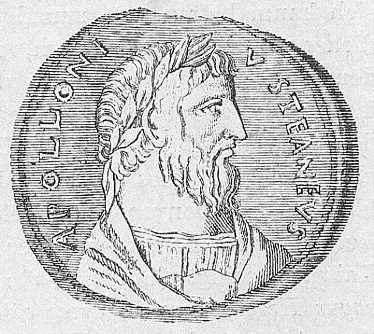Lessico
Tiana
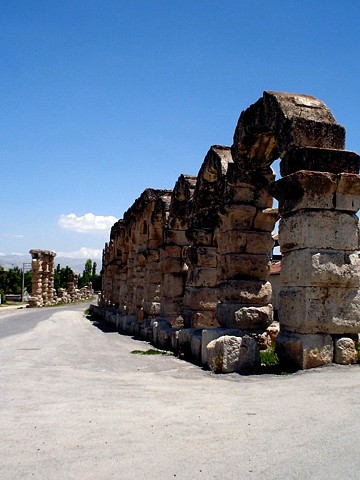
The ruins of Tyana (ancient Tuvanuva, Dana, Tyana) and a number of Roman waterways scattered over three hills between the villages of Bahçeli and Kemerhisar. These include the remains of a complex of Roman baths (Roma Hamami) and a limestone aqueduct dated from the reign of Caracalla (211-217 AD). The original supply of the aqueduct, the monumental pool of Bahçeli (Roma Havuzu, 5.5 km NE) is still well preserved. It sits at the foot of Kösk Höyük, a Hittite settlement excavated in 1981 that is turning out to be of great historical value. There are also other massive foundations of several large buildings, shafts, pillars, and one handsome column (replaced) still standing.
In greco Tıana,
in latino Tyana. Antica città dell'Asia Minore, nella Cappadocia,
presso l'odierno centro turco di Kemerhisar, 25 km a SSW di Nigde.
Preesistente all'invasione ittita, sotto il primo re ittita Labarna (verso il
1680-50 aC) divenne un grande centro religioso. Appartenne in seguito ai Frigi![]() e ai
Persiani
e ai
Persiani![]() . Divenuta
colonia romana nel sec. II e sede vescovile nella prima metà del secolo
successivo, passò quindi agli Arabi (sec. VIII-IX) e fu definitivamente
abbandonata intorno al Mille. Si ritiene che vi nacque Apollonio di Tiana
. Divenuta
colonia romana nel sec. II e sede vescovile nella prima metà del secolo
successivo, passò quindi agli Arabi (sec. VIII-IX) e fu definitivamente
abbandonata intorno al Mille. Si ritiene che vi nacque Apollonio di Tiana![]() , filosofo
neopitagorico del I secolo dC.
, filosofo
neopitagorico del I secolo dC.
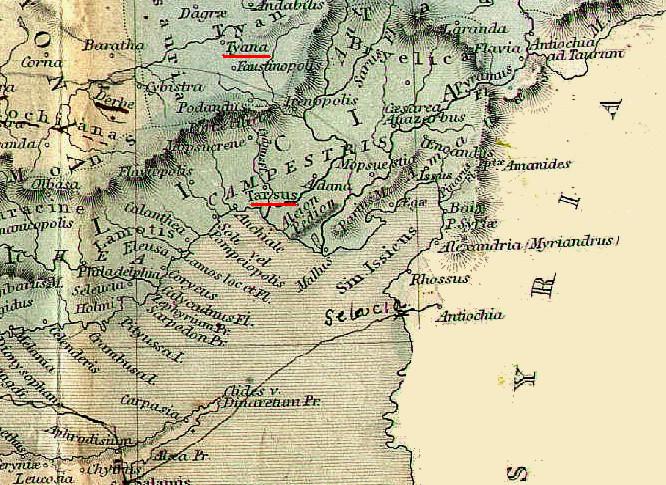
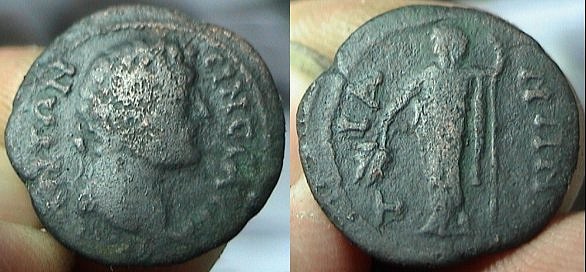
Antoninus
Pius AE18 of Tyana, Cappadocia. ΑΝΤΩΝ-ΕΙΝΟϹ
ΑVΓ, laureate head right /
ΤΥΑ-ΝΩΝ, Demeter (or Tyche of Tyana?) standing left holding
corn ears and torch.
Tyana (or Tyanna) was an ancient city of Anatolia, in modern south-central Turkey. It was the capital of a Hittite kingdom in the 2nd millennium BC, and had a long history as a Greek city state and later a Christian community. Tyana was a queen in Anatolia. Though now ruined, it is still officially the center of a Roman Catholic titular archbishopric in the former Roman province of Cappadocia Prima.
Tyana is probably the city referred to in Hittite archives as Tuwanuwa. In Greek legend the city was first called Thoana, because Thoas, a Thracian king, was its founder (Arrian, Periplus Ponti Euxini, vi); it was in Cappadocia, at the foot of Taurus Mountains and near the Cilician Gates (Strabo, XII, 537; XIII, 587). Xenophon mentions it in his book Anabasis, under the name of Dana, as a large and prosperous city. The surrounding plain was known after it as Tyanitis.
It was in a strategic position on the road to Syria via the Cilician Gates. It is the reputed birthplace of the celebrated philosopher (and reputed magician) Apollonius of Tyana in the first century. Under Roman Emperor Caracalla the city became Antoniana colonia Tyana. After having sided with Queen Zenobia of Palmyra it was captured by Aurelian in 272, who would not allow his soldiers to sack it, allegedly because Apollonius appeared to him, pleading for its safety.
In 371, Emperor Valens created a second province of Cappadocia, Cappadocia Secunda, of which Tyana became the metropolis. The ruins of Tyana are at modern Kemerhisar, three miles south of Nigde (in the former Ottoman province of Konya); there are remains of a Roman aqueduct and of cave cemeteries and sepulchral grottoes.
As noted, in 371 Emperor Valens created the province of Cappadocia Secunda, of which Tyana became the metropolis. This aroused a violent controversy between Anthimus, Bishop of Tyana, and St.Basil of Caesarea, each of whom wished to have as many suffragan sees as possible. About 640 Tyana had three, and it was the same in the tenth century (Heinrich Gelzer, "Ungedruckte ... Texte der Notitiae episcopatum", 538, 554). Le Quien (Oriens christianus, I, 395-402) mentions 28 bishops of Tyana, among whom were:
Eutychius, at Nice in 325
Anthimus, the rival of St. Basil
Aetherius, at Constantinople in 381
Theodore, the friend of St. John Chrysostom
Eutherius, the partisan of Nestorius, deposed and exiled in 431
Cyriacus, a Severian Monophysite.
In May, 1359, Tyana still had a metropolitan (Mikelosich and Müller, "Acta patriarchatus Constantinopolitani", I, 505); in 1360 the metropolitan of Caesarea secured the administration of it (op. cit., 537). Thenceforth the see was titular.
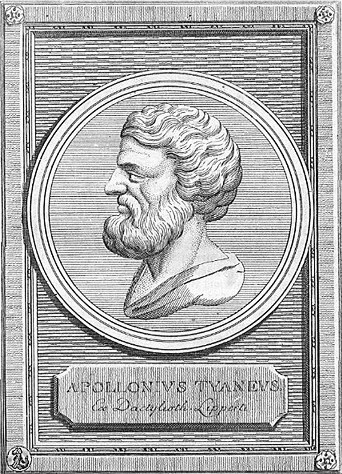
Apollønios Tyaneús:
filosofo neopitagorico![]() greco del secolo I dC.
Nella biografia redatta da Filostrato (sec. II-III) appare un uomo
straordinariamente virtuoso, fautore di una sorta di monoteismo e di un culto
interiore della divinità. Perseguitato in vita, ebbe culto e altari sotto gli
imperatori pagani dei sec. III e IV. Sulla base di elementi leggendari
elaborati da Filostrato (Vita di Apollonio di Tiana) si fece di lui un
personaggio da contrapporre a Cristo, attribuendogli soprattutto facoltà
taumaturgiche. In tal senso si sviluppò la polemica tra Eusebio di Cesarea
greco del secolo I dC.
Nella biografia redatta da Filostrato (sec. II-III) appare un uomo
straordinariamente virtuoso, fautore di una sorta di monoteismo e di un culto
interiore della divinità. Perseguitato in vita, ebbe culto e altari sotto gli
imperatori pagani dei sec. III e IV. Sulla base di elementi leggendari
elaborati da Filostrato (Vita di Apollonio di Tiana) si fece di lui un
personaggio da contrapporre a Cristo, attribuendogli soprattutto facoltà
taumaturgiche. In tal senso si sviluppò la polemica tra Eusebio di Cesarea![]() e Ierocle Sossiano, il
quale si servì della vita di Apollonio per dimostrare che i miracoli non
erano esclusivi del cristianesimo. La figura di Apollonio trovò credito anche
presso cristiani quali Ambrogio
e Ierocle Sossiano, il
quale si servì della vita di Apollonio per dimostrare che i miracoli non
erano esclusivi del cristianesimo. La figura di Apollonio trovò credito anche
presso cristiani quali Ambrogio![]() e Agostino
e Agostino![]() e ha tuttora estimatori tra
i teosofi. Del suo libro Dei sacrifici possediamo solo frammenti.
e ha tuttora estimatori tra
i teosofi. Del suo libro Dei sacrifici possediamo solo frammenti.
Apollonius of Tyana (Greek: Apollønios Tyaneús; ca. 40? - ca. 120 AD) was a Greek Pythagorean philosopher and teacher. He hailed from the town of Tyana in the Roman province of Cappadocia in Asia Minor. His date of birth is a matter of conjecture as some say he was roughly a contemporary of Jesus, in fact Eells (Life and Times of Apollonius, 1923, p.3) states his date of birth three years before Jesus of Nazareth, whose date of birth is also debatable.
However, Philostratus' the Elder (c170-247 AD) in Life of Apollonius, places him staying in the court of King Vardanes I of Parthia for a while, who ruled between c.40-47 AD. Apollonius began a five year silence at about the age of 20, and after the completion of this silence travelled to Mesopotamia and Iran. The text also mentions the emperors Nero, Vespasian, Titus, Domitian and Nerva at various points throughout Apollonius' life. Given this information, a timeline of roughly the years 15- 98 AD can be established for his life. After his death his name remained famous among philosophers and occultists.
By far the most detailed source is the Life of Apollonius of Tyana, a lengthy, novelistic biography written by the sophist Philostratus at the request of empress Julia Domna. She died in 217 AD, and he completed it after her death, between 217 and 238 AD. Philostratus' account shaped the image of Apollonius for posterity and still dominates discussions about him in our times. To some extent it is a valuable source because it contains data from older writings which were available to Philostratus but disappeared later on. Many think that it is full of obviously fictitious stories and dialogues. Modern Christian scholars challenge its credibility in many regards. They dismiss most of it as pure invention (either by Philostratus or by his sources). Philostratus' chronology, for instance, is often questioned. According to him, Apollonius lived from ca. 3 BC to about 97 AD, while many contend that he was born more than four decades later and died more than two decades later.
One of the essential sources Philostratus claimed to know are the "memoirs" (or "diary") of Damis, an alleged disciple and companion of Apollonius. Some scholars believe the notebooks of Damis are an invention of Philostratus, while others think it was a real book forged by someone else and used by Philostratus. In any case it is a literary fake. Philostratus describes Apollonius as a wandering teacher of philosophy and miracle worker who was active in Italy, Spain and Ethiopia and even travelled to Mesopotamia, Arabia and India. In particular, he tells lengthy stories of Apollonius entering the city of Rome in disregard of emperor Nero's ban on philosophers, and later on being summoned, as a defendant, to the court of emperor Domitian, where he defied the emperor in blunt terms. The latter charge had regarded the foretelling of a certain plague, to which Apollonius attributed to his prayer to Heracles and not to any sorcery on his part, arguing "[what wizard] would dedicate his personal achievement to a god?
Apollonius may have never left the Greek East. Many contend that he never came to Western Europe and was virtually unknown there till the third century AD when empress Julia Domna, who was herself an Easterner, decided to popularize him and his teachings in Rome. For that purpose she commissioned Philostratus to write the biography, where Apollonius is exalted as a fearless sage with supernatural powers, even greater than Pythagoras. Philostratus states that upon his death, Apollonius of Tyana underwent heavenly assumption. Subsequently Apollonius was worshipped by Julia's son emperor Caracalla and possibly also by her grand-nephew emperor Severus Alexander.
Two biographical sources earlier than Philostratus are lost: a book by emperor Hadrian's secretary Maximus of Aegae describing Apollonius' activities in the city of Aegae in Cilicia, and a biography by a certain Moiragenes.
Historical facts
Little can be derived from sources other than Philostratus. Hence if we dismiss Philostratus' colorful stories as fiction, the figure of the historical Apollonius appears to be rather shadowy. As James Francis put it, "the most that can be said is that Apollonius appears to have been a wandering ascetic/philosopher/wonderworker of a type common to the eastern part of the early empire." What we can safely assume is that he was indeed a Pythagorean and as such, in conformity with the Pythagorean tradition, opposed animal sacrifice, and lived on a frugal, strictly vegetarian diet. He seems to have spent his entire life in the cities of his native Asia Minor and of northern Syria, in particular his home town of Tyana, Ephesus, Aegae, and Antioch. As for his philosophical convictions, we have an interesting, probably authentic fragment of one of his writings (On sacrifices) where he expresses his view that God, who is the most beautiful being, cannot be influenced by prayers or sacrifices and has no wish to be worshipped by humans, but can be reached by a spiritual procedure involving nous, because he himself is pure nous and nous is also the greatest faculty of mankind. The life of Jesus of Nazareth is often compared to that of Apollonius of Tyana. Whereas Apollonius has been recorded by many ancient races as a true historical figure, whereas his work lasted six to eight decades, Jesus' whose image, life works and teachings closely parallel that of Apollonius, only lasted three years. In 325 AD in Nicia, when the Church of Rome was officially formed, the memory of Apollonius was banished, his writings burned, and he branded the "anti-christ".
Extra-sensory perception
Apollonius was credited with extra-sensory perceptions. When emperor Domitian was murdered on September 18, 96 AD, Apollonius allegedly witnessed the event in Ephesus on precisely the day and hour it happened in Rome, and told those present what he saw. Both Philostratus and renowned historian Cassius Dio report this incident, probably on the basis of an oral tradition. Both state that the philosopher welcomed the deed as a praiseworthy tyrannicide.
Journey to India
Philostratus devoted two and a half of the eight books of his Life of Apollonius (1.19-3.58) to the description of a journey of his hero to India. According to Philostratus' Life, en route to the Far East, Apollonius reached Hierapolis Bambyce (Manbij) in Syria (not Nineveh, as some scholars believed), where he met Damis, a native of that city who became his lifelong companion. Pythagoras, whom the Neo-Pythagoreans regarded as an exemplary sage, was believed to have travelled to India. Hence such a feat made Apollonius look like a good Pythagorean who spared no pains in his efforts to discover the sources of oriental piety and wisdom. As some details in Philostratus' account of the Indian adventure seem incompatible with known facts, modern scholars are inclined to dismiss the whole story as a fanciful fabrication, but not all of them rule out the possibility that the Tyanean actually did visit India.
On the other hand, there seemed to be independent evidence showing that Apollonius was known in India. In two Sanskrit texts quoted by Sanskritist Vidhushekhara Bhattacharya in 1943 he appears as "Apalunya", in one of them together with Damis (called "Damisa"). There it is claimed that Apollonius and Damis were Western yogis who held wrong Buddhist views, but later on were converted to the correct Advaita philosophy. Classical philologists believed that these Indian sources derived their information from a Sanskrit translation of Philostratus' work (which would have been a most uncommon and amazing occurrence), or even considered the possibility that it was really an independent confirmation of the historicity of the journey to India. Only in 1995 were the passages in the Sanskrit texts proven to be interpolations by a modern (late 19th century) forger.
Writings
Several writings and many letters have been ascribed to Apollonius, but some of them are lost (if they ever existed); others have only been preserved in parts or fragments of disputed authenticity. Porphyry and Iamblichus refer to a biography of Pythagoras by Apollonius, which has not survived; it is also mentioned in the Suda. Apollonius wrote a treatise On sacrifices, of which only a short, probably authentic fragment has come down to us.
Philostratus' Life and the anthology assembled by John Stobaeus contain purported letters of Apollonius. Some of them are cited in full, others only partially. Besides, there is an independently transmitted collection of letters preserved in medieval manuscripts. It is difficult to determine what is authentic and what not. Some of the letters were forgeries or literary exercises assembled in collections which were already circulated in the 2nd century AD. In any case there is no doubt that Philostratus himself forged a considerable part of the letters he inserted into his work; others were older forgeries available to him.
Antiquity
In the second century the satirist Lucian of Samosata was a sharp critic of Neo-Pythagoreanism. After 180 AD he wrote a pamphlet where he attacked Alexander of Abonoteichus, a student of one of Apollonius students, as a charlatan, and suggested that the whole school was based on fraud. From this we can infer that Apollonius really had students and that his school survived at least till Lucians time. One of Philostratus foremost aims was to oppose this view; although he related various miraculous feats of Apollonius, he emphasized at the same time that his hero was not a magician, but a serious philosopher and a champion of traditional Greek values.
When emperor Aurelian conducted his military campaign against the Palmyrene Empire, he captured Tyana in 272 AD. According to the Historia Augusta he abstained from destroying the city after having a vision of Apollonius admonishing him to spare the innocent citizens.
In Philostratus description of Apollonius life and deeds there are a number of similarities with the life and especially the claimed miracles of Jesus. Perhaps this parallel was intentional, but the original aim was hardly to present Apollonius as a rival of Jesus. However, in the late third century Porphyry, an anti-Christian Neoplatonic philosopher, claimed in his treatise Against the Christians that the miracles of Jesus were not unique, and mentioned Apollonius as a non-Christian who had accomplished similar achievements. Around 300, Roman authorities used the fame of Apollonius in their struggle to wipe out Christianity. Hierocles, one of the main instigators of the persecution of Christians in 303, wrote a pamphlet where he argued that Apollonius exceeded Christ as a wonder-worker and yet wasnt worshipped as a god, and that the cultured biographers of Apollonius were more trustworthy than the uneducated apostles. This attempt to make Apollonius a hero of the anti-Christian movement provoked sharp replies from bishop Eusebius of Caesarea and from Lactantius. Eusebius wrote an extant reply to the pamphlet of Hierocles, where he claimed that Philostratus was a fabulist and that Apollonius was a sorcerer in league with demons. This started a debate on the relative merits of Jesus and Apollonius that has gone on in different forms into modern times.
In Late Antiquity talismans allegedly made by Apollonius appeared in several cities of the Eastern Roman Empire, as if they were sent from heaven. They were magical figures and columns erected in public places, meant to protect the cities from afflictions. The great popularity of these talismans was a challenge to the Christians. Some Byzantine authors condemned them as sorcery and the work of demons, others admitted that such magic was beneficial; none of them claimed that it didnt work. In the Western Roman Empire, Sidonius Apollinaris was a Christian admirer of Apollonius in the 5th century. He produced a Latin translation of Philostratus Life, which is lost.
Modern era
In Europe, there has been great interest in Apollonius since the beginning of the 16th century, but the traditional ecclesiastical viewpoint still prevailed. Till the Age of Enlightenment the Tyanean was usually treated as a demonic magician and a great enemy of the Church who collaborated with the devil and tried to overthrow Christianity. On the other hand, several advocates of Enlightenment, deism and anti-Church positions saw him as an early forerunner of their own ethical and religious ideas, a proponent of a universal, non-denominational religion compatible with Reason. In 1680, Charles Blount, a radical English deist, published the first English translation of the first two books of Philostratus' Life with an anti-Church introduction. Voltaire praised Apollonius.
As in Late Antiquity, comparisons between Apollonius and Christ became commonplace in the 17th and 18th centuries in the context of polemic about Christianity. In the Marquis de Sade's "Dialogue Between a Priest and a Dying Man", the Dying Man compares Jesus to Apollonius as a false prophet. Some Theosophists, notably C.W. Leadbeater, Alice A. Bailey, and Benjamin Creme, have maintained that Apollonius of Tyana was the reincarnation of the being they call the Master Jesus. In the 20th century, Ezra Pound evoked Apollonius in his later Cantos as a figure associated with sun-worship and a messianic rival to Christ. Pound identifies him as Aryan within an anti-semitic mythology, and celebrates his solar worship and aversion to ancient Jewish animal sacrifice. In the Gerald Messadié's "The man who became god", Apollonius appears as a wandering philosopher and magician of about the same age as Jesus. The two of them supposedly met.
In fiction
Apollonius appears as a fictional character in the 1935 novel The Circus of Dr. Lao, as well as the 1964 film adaptation 7 Faces of Dr. Lao. In these works, Apollonius works in the circus as a fortune-teller, who is under a curse he sees the future, but can only speak the exact truth, thus seems to be cruel and hateful. He is portrayed as being blind, and apparently weary of many years of predicting disappointment for his listeners.
Apollonius appears as a fictional character in the 1977 television series The Fantastic Journey in the seventh episode named Funhouse. In this episode, Apollonius attempts to take possession of the scientist Willaway in a funhouse but is thwarted by Varian, "a man from the future possessing awesome powers".
